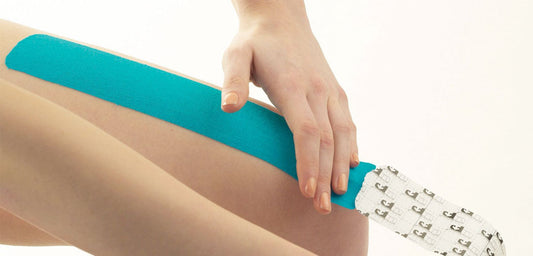
Is Kinesiology Taping Effective?
Share
The scientific evidence for the effectiveness of kinesiology tape is mixed and often inconclusive. While some studies suggest that kinesiology tape provides certain benefits, such as pain relief and improved muscle function, others do not find significant effects.
It's important to note that the quality of research in this field varies, and more high-quality studies are needed to draw definitive conclusions.
Here is a summary of some key findings and areas where kinesiology tape has been studied:
Pain Relief
Some studies have report that kinesiology tape may help reduce pain in various conditions. For example, musculoskeletal injuries, muscle strains, patellofemoral pain syndrome (runner's knee) and shoulder pain.
So why does it work? One proposed mechanism is that the tape lifts the skin slightly. As a result, this reduces pressure on pain receptors, therefore increasing blood flow. However, the pain relief reported is often modest, and the clinical significance is debated.
Improvement in Muscle Function
Kinesiology tape is sometimes used to support and facilitate muscle function. Some studies suggest that it might help improve muscle activation and enhance muscle performance in certain situations. Athletes may use it to provide additional support to specific muscle groups.
Lymphatic Drainage
Kinesiology taping techniques are believed to help with lymphatic drainage and reduce localised swelling. However, the evidence supporting this effect is limited, and the mechanisms are not fully understood.
Range of Motion: Kinesiology tape is designed to be elastic and allow a range of motion. Some studies have investigated its impact on joint range of motion, particularly in cases of joint injury or instability. Results vary, and the effects may be small.
Athletic Performance
Athletes sometimes use kinesiology tape with the hope of improving their performance. However, the scientific evidence on its direct impact on athletic performance is limited and inconsistent.
Postural Correction
Some proponents of kinesiology tape claim it can assist with postural correction by providing sensory input to the body. However, the scientific support for this application is minimal.
It's important to approach the use of kinesiology tape with a degree of caution andscepticism. While some individuals report positive outcomes and benefits, the placebo effect (where people feel better because they believe the treatment is working) can play a role in these perceptions.
Considerations
If you're considering using kinesiology tape for a specific condition or injury, it's advisable to consult with a healthcare provider or a physical therapist. They can provide guidance on whether kinesiology tape is an appropriate part of your treatment plan and ensure that it is applied correctly.
Additionally, keep in mind that kinesiology tape should not be used as a sole or primary treatment for serious medical conditions or injuries, and it should complement other evidence-based therapies.
Scientific studies
The following are summaries of specific research papers:
Patellofemoral pain:
- Publication: A 2016 systematic review and meta-analysis in "Physical Therapy in Sport".
- Findings: The review explored the use of kinesiology taping for patellofemoral pain syndrome (PFPS) and found it might offer short-term pain relief and functional improvement. However, the evidence quality was generally low, highlighting the need for more high-quality studies.
Rotator cuff:
- Publication: A 2016 randomised controlled trial in the "Journal of Shoulder and Elbow Surgery".
- Findings: The trial evaluated kinesiology taping in patients with rotator cuff tendinopathy, showing short-term pain relief and improved shoulder function compared to placebo tape. The long-term benefits remained uncertain.
Ankle sprains:
- Publication: A 2017 study in the "Journal of Sport Rehabilitation".
- Findings: This study examined kinesiology taping for acute ankle sprains and found immediate pain relief and improved ankle range of motion compared to placebo tape.







